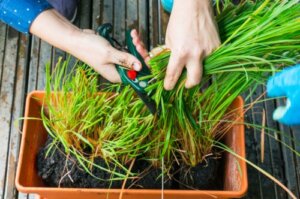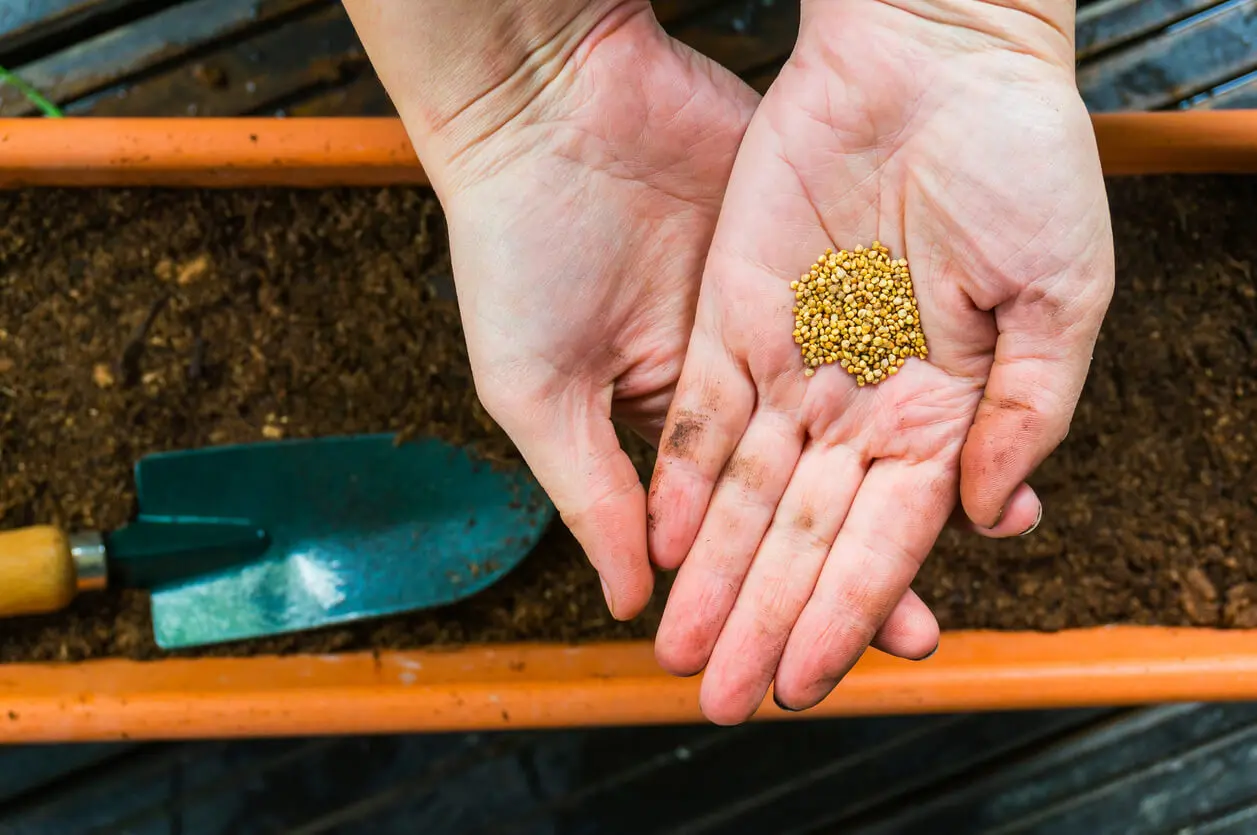Lemongrass or Citronella: Cultivation and Care

There’s a plant that can be used for medicinal, gastronomic, and ornamental uses and can even be used to repel mosquitoes. Lemongrass or citronella has very special characteristics that make it cover all these possibilities, in addition to having a simple way of cultivation.
It seems surprising that the plant used to repel insects is the same that forms the basis of Thai curry. Because of its citrus contributions, lemongrass has many uses in gastronomy.
On the other hand, the care it requires is basic. However, due to its adaptation to tropical climates, it’s not very resistant to cold temperatures.
What is lemongrass or citronella?
Its scientific name is Cymbopogon citratus, but it’s known as lemongrass or citronella, depending on the region of the planet it’s being cultivated in and the unique characteristics of the plant. It’s a species native to Southeast Asia, especially in countries such as India and Sri Lanka. The genus Cymbopogon has more than 55 species and belongs to the Poaceae family, better known as grasses.
This family includes plants that form the basis of the world’s food supply, such as wheat, sorghum, corn, and oats. Citronella, although less known, also has a strong influence on gastronomy. It’s often used in infusions such as tea, tereré, and mate in parts of South America. Also, some cooks use it in different soups and to season fish or seafood.
This plant belongs to the perennial category, as it can survive for more than two years without needed to be replanted. It presents a robust format and a set of clusters with spikes and flowers combined with long aromatic leaves.
It can measure up to 1.5 meters in height, but one of its most outstanding characteristics is the solid stem, from which its characteristic flavor is released.
Like this article? You may also like to read: What Are Essential Oils and How and Why Do They Work?
Different uses of the lemongrass plant
This is one of the most versatile plants in terms of its forms of use. Gastronomy, medicine, and ornamental application are some of the fields in which citronella demonstrates effectiveness.
- Digestion: Lemongrass has digestive properties, from which it derives its application for different infusions.
- Gastronomy: It’s a very popular ingredient in Southeast Asian cuisine to flavor meats or rice. The stem should be crushed and added to any boiled cooking, whether rice or noodles. Lemongrass is used as a base for Thai curries to season fish or vegetables.
- Repellent: It has properties to repel mosquitoes, so it’s used as a base for the preparation of oils for this purpose.
- Aromatic: Thanks to its citrus fragrance, lemongrass is also used in perfumery and aromatherapy oils.
- Cosmetic: It’s used to improve oily skin and wrinkles.

Lemongrass or citronella care
This is a plant whose origin is in hot environments, so it’s best suited to tropical and subtropical climates. It’s in these conditions where it’s most naturally cultivated. As for home care, it’s important that it grows in spaces with good direct sunlight.
Temperatures should be temperate, as citronella does not tolerate frost. In the case of living in very cold areas, with temperatures below 0 degrees, it’s advisable to grow it in a pot indoors. On the other hand, it requires soil that’s fertilized with manure or any regular fertilizer.
During the summer months, it’s advisable that the plant is outdoors, in direct contact with sunlight. In this case, it should receive frequent watering.
For the last days of the warm season, bring it indoors, but with abundant lighting. Also, reduce water levels a bit.
Ways to grow lemongrass or citronella
There are several different ways to grow a lemongrass plant for the first time. Thanks to its ease of care and growth, this plant is possible to do the deed by means of its cuttings, its stems, or its seeds. None of these options presents any major difficulties.
By stem cuttings or tillers
When the plant has reached considerable growth, it should be transplanted from the pot into the ground. At this stage, it’s possible to take cuttings in order to grow a new specimen of lemongrass.
Growing lemongrass or citronella by using the stems
In addition to its application in the kitchen, the stems of the plant can be used to generate new specimens. In this case, they should be placed in a glass of water, which should receive abundant light.
Within 2 or 3 weeks, roots will begin to appear. In the meantime, the water should be renewed whenever it becomes dark.
Once the roots appear, cut the upper end of the stem and transfer it to a pot with fertilized soil. After the first two weeks, renew the substrate and fertilize it with worm castings or compost. Repeat the action twice a month and, in the meantime, water constantly.
Grow from seeds
For this method, it’s advisable to have a site with plenty of light and a warm temperature. The seeds require these conditions to start growing.
In addition, it’s important to start the process at the end of winter in order to take advantage of the spring months. Once the first seedlings appear, place 2 or 3 of them in a pot and bring them near a window.

By bush division
Another way to reproduce the plant is to multiply it through bush division. This is a very simple task that consists of separating the plant and transferring the root ball to another pot.
In this case, growth will be even faster and easier. Just apply frequent watering, fertilize the soil organically and provide good light.
We think you may also enjoy reading this article: Bergamot Essential Oil: Benefits and Possible Side Effects
A plant with multiple benefits
Citronella is a must-have plant if you have outdoor spaces, such as terraces or gardens. This is especiallytrue when the months of extreme heat arrive, since it works as a natural mosquito repellent.
However, it’s also an ideal species for decoration. Its shrub-like growth can adorn any patio.
All cited sources were thoroughly reviewed by our team to ensure their quality, reliability, currency, and validity. The bibliography of this article was considered reliable and of academic or scientific accuracy.
- Linares, Sonia, Antolinez González, Juan Carlos, Darghan, Enrique, de Colmenares, Nélida G., Usubillaga, Alfredo, Evaluación de variables agronómicas en el cultivo delimonaria (Cymbopogon citratus Stapf) para la producción deaceite esencial. Interciencia [Internet]. 2008;33(9):693-699. Recuperado de: https://www.redalyc.org/articulo.oa?id=33933912
- Magotra, Sumeet, Ajeet Pal Singh, and Amar Pal Singh. “A Review on Pharmacological Activities of Cymbopogon Citratus.” International Journal of Pharmaceutics and Drug Analysis (2021): 151–157. Disponible en: https://doi.org/10.47957/ijpda.v9i2.475
- Guerrero – Beltrán, José Ángel, Vázquez – Briones, María del Carmen, Efecto del aceite esencial de Cymbopogon citratus sobre propiedades fisicoquímicas en películas de quitosano. Scientia Agropecuaria [Internet]. 2017;8(4):401-409. Recuperado de: https://www.redalyc.org/articulo.oa?id=357653912011
- Basera, Priyanka et al. “Analytical Investigation of Cymbopogon Citratus and Exploiting the Potential of Developed Silver Nanoparticle against the Dominating Species of Pathogenic Bacteria.” Frontiers in Microbiology 10.FEB (2019). Disponible en: https://doi.org/10.3389/fmicb.2019.00282
- Álvarez Morales, Laura, Salazar Yepes, Mauricio, CARACTERIZACIÓN MORFOLÓGICA DE LAS ROYAS (PUCCINIALES) QUE AFECTAN EL LIMONCILLO (Cymbopogon citratus (DC.) Stapf) EN COLOMBIA. Bioagro [Internet]. 2014;26(3):171-176. Recuperado de: https://www.redalyc.org/articulo.oa?id=85732357006
This text is provided for informational purposes only and does not replace consultation with a professional. If in doubt, consult your specialist.








